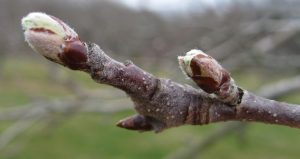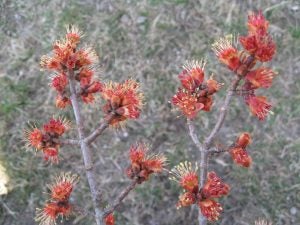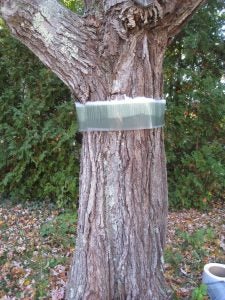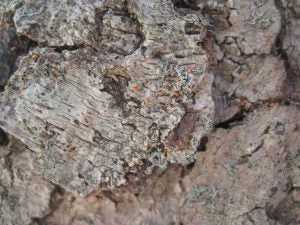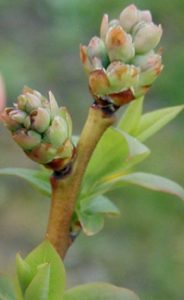March 22, 2021 Winter moth update
Winter moth update, March 24, 2021
Winter moth populations have been decreasing for several years, though they can still be a problem for people growing apples, pears, and blueberries. Over the last decade, winter moth eggs started hatching anywhere from mid-March to mid-April, depending primarily on temperature. Last year they started hatching on March 20th. I don’t expect eggs to begin hatching until after red maples start blooming and when McIntosh apple buds crack open, exposing a little bit of green tissue (called Green Tip). Hopefully, this is still a couple of weeks away, but warm weather this week is pushing things along.
Winter moth eggs tend to hatch at McIntosh apple ‘green tip’ and red maple bloom.
Tree wraps were set up in early November, 2020, to monitor eggs at 3 locations in RI – Charlestown, Kingston, and Portsmouth. In November and December, as female winter moths climbed trees and encountered tree wraps, female moths deposited eggs below the wraps, aggregating eggs, and making it easier to monitor eggs hatching. Winter moth eggs are orange now, but turn blue a couple of days before hatching. This trait makes it very handy for monitoring egg hatch!
Tree wraps in place while adults moths are active in November and December. Winter moth eggs are tiny and orange, barely visible on the green-bluish lichen.
Tree wraps were removed last week, and 2 of 3 locations have fewer eggs than in 2020. In Portsmouth I found only 6 eggs compared to 80 found there last year. In Charlestown there are 373 eggs to monitor and last year there were 500 eggs. In Kingston I found the same number of eggs both years, 136 eggs.
Overall, it seems that winter moth populations continue to decline in southeastern New England. In November and December several people contacted me about seeing clouds of male winter moths flying, but I don’t think this will lead to any winter moth outbreaks. For the last few years, no insecticides have been needed to control winter moth caterpillars in landscape trees. Winter moth caterpillars will always be with us, but the population should stay under control and not require pesticide applications.
Growers of fruit (apple, pear, and blueberry) may need to apply insecticides against winter moths. Winter moth caterpillars hatch early in spring and enter developing buds. The problem for apple, pear, and blueberry plants is winter moth caterpillars enter flower buds. It doesn’t take a very large population of winter moth caterpillars to cause significant damage to flowers and therefore to the crop.
We don’t have a really good threshold to indicate whether or not to spray apples, pears, or blueberries for winter moth caterpillars. Some Nova Scotia guides recommend spraying apple trees when 1-2 caterpillars are found in 20 buds (>5% infested buds). A good time to spray for winter moths is at tight cluster or bud separation – when the flower buds start separating from the cluster, but before blossoms open. We are several weeks away from this bud stage. All common insecticides labeled for apples and blueberries control winter moth caterpillars well. Bt insecticides (such as Dipel) are also effective. Bt insecticides kill only caterpillars so don’t harm bees and other insects.
Apple tight cluster and apple bud separation are good times to look for caterpillars. Blueberry tight cluster is also a good time to check, but it is more difficult to check blueberry flower buds than apple flower buds.
The URI Plant Clinic has moved into the Skogley Turf Research Center, but you can still drop off or mail samples to 3 East Alumni Ave., Kingston, RI 02881. There is a$10 charge for landscapers and plant owners.
Heather Faubert
URI Cooperative Extension
 Home
Home Browse
Browse Close
Close Events
Events Maps
Maps Email
Email Brightspace
Brightspace eCampus
eCampus




